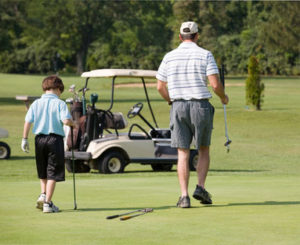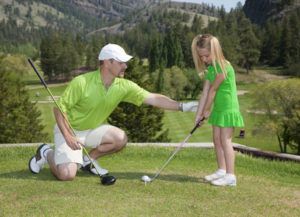 When children learn to play golf, they can start to gain skills that will benefit them throughout their lives. The game involves constant learning and practicing as they hone their skills. It can also help to make them humble and to learn how to lose graciously. The benefits of golf training for children are numerous, and it aids in their emotional, social, and physical development. Golf also provides a great opportunity for parents to bond with their children while they play together. Parent and child golf tournaments offer you a great opportunity to talk to your child while you have fun and enjoy the outdoors together. When you sign up for a parent and child golf tournament, you and your child will have the opportunity to spend hours together of uninterrupted time. Here are some of the benefits that golf training and tournaments have to offer to your children and to you.
When children learn to play golf, they can start to gain skills that will benefit them throughout their lives. The game involves constant learning and practicing as they hone their skills. It can also help to make them humble and to learn how to lose graciously. The benefits of golf training for children are numerous, and it aids in their emotional, social, and physical development. Golf also provides a great opportunity for parents to bond with their children while they play together. Parent and child golf tournaments offer you a great opportunity to talk to your child while you have fun and enjoy the outdoors together. When you sign up for a parent and child golf tournament, you and your child will have the opportunity to spend hours together of uninterrupted time. Here are some of the benefits that golf training and tournaments have to offer to your children and to you.
Benefits of golf training for children
Learning the game of golf can allow your child to acquire skills that will benefit them in all areas of their lives. They will be able to make lifelong friends and learn etiquette from the rules of the game. Golf also helps children to acquire other skills that will benefit them in their future careers. They can gain self-confidence, learn how to solve problems, and become more comfortable working with numbers.
Playing golf also helps with physical development. Playing a game means that your children will be outside in the fresh air for hours instead of watching television. The game involves a significant amount of walking so that your children will be getting exercise while they are having fun. Golf training provides children with a solid foundation for character development, and the skills that they learn can benefit them in many types of sports.
How parent/child golf tournaments can benefit you and your children
If your children are learning to play golf, signing up for parent and child golf tournaments can offer benefits to both you and your children. Tournaments allow you to spend one-on-one time with your child for hours, which can help you to bond more. You can also help them to correct mistakes while improving their skills. Participating in parent and child golf tournaments will give both of you plenty of exercise while you have fun together. The hours of time that you spend together can create lasting memories that your child will always treasure.
To find parent and child golf tournaments in Georgia that you can sign up for with your child, you can search in your area. The GSGA Junior Golf has a list of events on its website, allowing you to find tournaments that are close to you.
Golf training offers many great benefits to children socially, emotionally, and physically. Playing golf with your child also can help you to build a strong relationship together while you bond over the game. Aussie Kids Golf Academy has four locations in the Atlanta metropolitan area and offers golf lessons for children. Call us or visit us at Aussie Kids Golf Academy!




 Young children who are enrolled in a golf academy for kids at an early age learn to have confidence in their abilities. Youngsters enjoy comparing their previous attempts at playing golf to their current, improved undertakings. From learning new skills to attaining their goals, kids develop greater self-assurance.
Young children who are enrolled in a golf academy for kids at an early age learn to have confidence in their abilities. Youngsters enjoy comparing their previous attempts at playing golf to their current, improved undertakings. From learning new skills to attaining their goals, kids develop greater self-assurance. The winter is a great time to get together with family and spend time together. However, every parent knows how hard it can be to manage the winter with children. During the summer, kids like to play outside. During the winter, on the other hand, children often have to spend more time inside. This resulting cabin fever is a problem for kids and adults alike. We believe that this problem can be easily addressed with a quality after-school sports kids winter program.
The winter is a great time to get together with family and spend time together. However, every parent knows how hard it can be to manage the winter with children. During the summer, kids like to play outside. During the winter, on the other hand, children often have to spend more time inside. This resulting cabin fever is a problem for kids and adults alike. We believe that this problem can be easily addressed with a quality after-school sports kids winter program.






 Our 11,000 square-foot Buckhead Academy has been specifically designed to allow all facets of the game to be practiced in a safe and friendly setting.
Our 11,000 square-foot Buckhead Academy has been specifically designed to allow all facets of the game to be practiced in a safe and friendly setting.